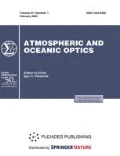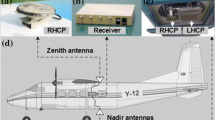Abstract
An algorithm is considered for retrieving the reflection coefficients of the Earth’s surface taking into account radiation polarization. The algorithm was tested for five MODIS channels in three areas: south of Tomsk region, Moscow region, and Irkutsk region. Test points at the center of coniferous forest massifs in the summer season were used to estimate the error of the algorithm. Results from our algorithm with and without accounting for polarization, from the MOD09 algorithm, and results without atmospheric correction were compared with measurements taken as reference. The comparison shows that the average values obtained by our algorithm taking into account polarization are closer to the reference data than those obtained using the MOD09 NASA algorithm in MODIS channels 1 (0.620–0.670 μm), 3 (0.459–0.479 μm), and 4 (0.545–0.565 μm), and the difference on the same order of magnitude is observed in MODIS channel 2 (0.841–0.876 μm). In MODIS channel 8 (0.405–0.420 μm), one algorithm is preferable in some situations and the other otherwise.






Similar content being viewed by others
REFERENCES
J. Otterman and R. S. Fraser, “Adjacency effects on imaging by surface reflection and atmospheric scattering: Cross radiance to zenith,” Appl. Opt. 18 (16), 2852–2860 (1979).
E. F. Vermote and A. Vermeulen, Atmospheric correction algorithm: Spectral reflectances (MOD09). Algorithm Theoretical Background document, version 4.0. 1999. http://modis.gsfc.nasa.gov/atbd/atbd_nod08.pdf. Cited March 9, 2019.
M. Putsay, “A simple atmospheric correction method for the short wave satellite images,” Int. J. Remote Sens. 13 (8), 1549–1558 (1992).
P. N. Reinersman and K. L. Carder, “Monte Carlo simulation of the atmospheric point-spread function with an application to correction for the adjacency effect,” Appl. Opt. 34 (21), 4453–4471 (1995).
F. M. Breon and E. Vermote, “Correction of MODIS surface reflectance time series for BRDF effects,” Remote Sens. Environ. 125, 1–9 (2012).
A. Lyapustin, J. Martonchik, Y. Wang, I. Laszlo, and S. Korkin, “Multiangle Implementation of Atmospheric Correction (MAIAC): 3. Atmospheric correction,” Remote Sens. Environ. 127, 385–393 (2012).
E. F. Vermote, N. El. Saleous, C. O. Justice, Y. J. Kaufman, J. L. Privette, L. Remer, J. C. Roger, and D. Tanre, “Atmospheric correction of visible to middle-infrared EOS-MODIS data over land surfaces: Background, operational algorithm and validation,” J. Geophys. Res. D 102 (14), 17,131 (1997).
D. Tanre, B. N. Holben, and Y. J. Kaufman, “Atmospheric correction algorithm for NOAA-AVHRR products: Theory and application,” IEEE Trans. Geosci. Remote Sens. 30 (2), 231–248 (1992).
D. J. Diner and J. V. Martonchik, “Atmospheric transfer of radiation above an inhomogeneous non-Lambertian reflective ground. 1. Theory,” J. Quant. Spectrosc. Radiat. Transfer 31 (2), 97–125 (1984).
T. Y. Lee and Y. J. Kaufman, “Non-Lambertian effects on remote-sensing of surface reflectance and vegetation index,” IEEE Trans. Geosci. Remote Sens. 24 (5), 699–708 (1986).
M. Leroy, J. Deuze, F. Breon, O. Hautecoeur, M. Herman, J. Buriez, D. Tanre, S. Bouffies, P. Chazette, and J. Roujean, “Retrieval of atmospheric properties and surface bidirectional reflectances over land from POLDER/ADEOS,” J. Geophys. Res. 102, 17023–17037 (1997).
J.-L. Roujean, D. Tanre, F.-M. Breon, and J.-L. Deuze, “Retrieval of land surface parameters from airborne POLDER bidirectional reflectance distribution function during HAPEX-Sahel,” J. Geophys. Res. D 102 (10), 11201–11218 (1997).
D. J. Diner, J. V. Martonchik, C. Borel, S. A. W. Gerstl, H. R. Gordon, Y. Knyazikhin, R. Myneni, B. Pinty, and M. Verstraete, Multi-Angle Imaging Spectro-Radiometer Level 2 Surface Retrieval Algorithm Theoretical Basis (Jet Propulsion Laboratory: La Canada Flintridge, CA, USA, 2008).
L. V. Katkovskii, ”Parameterization of outgoing radiation for quick atmospheric correction of hyperspectral images,” Opt. Atmos. Okeana 29 (9), 778–784 (2016).
S. A. Lisenko, “Atmospheric correction of multispectral satellite images based on the solar radiation transfer approximation model,” Atmos. Ocean. Opt. 31 (1), 72–85 (2018).
D. Tanre, B. N. Holben, and Y. J. Kaufman, “Atmospheric correction algorithm for NOAA-AVHRR products: Theory and application,” IEEE Trans. Geosci. Remote Sens. 30 (2), 231–248 (1992).
M. V. Tarasenkov and V. V. Belov, “Software package for reconstructing reflective properties of the Earth’s surface in the visible and UV ranges,” Atmos. Ocean. Opt. 28 (1), 89–94 (2015).
M. V. Tarasenkov, V. V. Belov, and M. V. Engel, “Algorithm for reconstruction of the Earth surface reflectance from modis satellite measurements in a turbid atmosphere,” Proc. SPIE—Int. Soc. Opt. Eng. 10833, CID: 10833 16 [10833-58] (2018).
Gaofei Yin, Ainong Li, Shengbiao Wu, Weiliang Fan, Yelu Zeng, Kai Yan, Baodong Xu, Jing Li, and Qinhuo Liu, “PLC: A simple and semi-physical topographic correction method for vegetation canopies based on path length correction,” Remote Sens. Environ. 215, 184–198 (2018).
V. A. Egorov and S. A. Bartalev, “Radiometric correction for topography-induced distortions in land cover reflectance derived from satellite data,” Sovremennye Problemy Distantsionnogo Zondirovaniya Zemli Kosmosa 13 (5), 192–201 (2016).
M. V. Tarasenkov, I. V. Kirnos, and V. V. Belov, “Observation of the Earth’s surface from the space through a gap in a cloud field,” Atmos. Ocean. Opt. 30 (1), 39–43 (2017).
T.A. Germogenova, “About the effect of polarization on the scattering radiation intensity distribution,” Izv. Akad. Nauk SSSR. Ser. Geofiz. No. 6, 854–856 (1962).
T. A. Sushkevich, Mathematical Models for Radiation Transfer (BINON. Laboratoriya znanii, Moscow, 2005) [in Russian].
M. A. Nazaraliev, Statistical Simulation of Radiative Processes in the Atmosphere (Nauka, Moscow, 1990) [in Russian].
A. V. Zimovaya, M. V. Tarasenkov, and V. V. Belov, “Radiation polarization effect on the retrieval of the Earth’s surface reflection coefficient from satellite data in the visible wavelength range,” Atmos. Ocean. Opt. 31 (2), 131–136 (2018).
A. V. Zimovaya, M. V. Tarasenkov, and V. V. Belov, “Effect of radiation polarization on reconstruction of the Earth’s surface reflection coefficient from satellite data in the visible wavelength range,” Proc. SPIE—Int. Soc. Opt. Eng. 10466, CID: 10466 10 [10466-54] (2017).
Aerosol Robotic Network (AERONET). http://aeronet.gsfc.nasa.gov. Cited March 9, 2019.
C. Bohren and D. Huffman, Absorption and Scattering of Light by Small Particles (Wiley, 1998).
F. X. Kneizys, E. P. Shettle, G. P. Anderson, L. W. Abreu, J. H. Chetwynd, J. E. A. Selby, S. A. Clough, and W. O. Gallery, User guide to LOWTRAN-7. ARGL-TR-86-0177. ERP 2010 (Hansom AFB, MA, 2010).
URL: https://lpdaac.usgs.gov/data_access. Cited March 9, 2019.
A. Bucholtz, “Rayleigh-scattering calculations for the terrestrial atmosphere,” Appl. Opt. 34 (15), 2765–2773 (1995).
G. I. Marchuk, G. A. Mihajlov, M. A. Nazaraliev, R. A. Darbinyan, B. A. Kargin, and B. S. Elepov, Monte Carlo Method in Atmospheric Optics (Nauka, Novosibirsk, 1976) [in Russian].
V. V. Belov, M. V. Tarasenkov, and K. P. Piskunov, “Parametrical model of solar haze intensity in the visible and UV ranges of the spectrum,” Opt. Atmos. Okeana 23 (4), 294–297 (2010).
E. L. Krinov, Spectral Reflectivity of Natural Formations (Publishing House of AS USSR, Leningrad, 1947) [in Russian].
Author information
Authors and Affiliations
Corresponding authors
Ethics declarations
The authors declare that they have no conflicts of interest.
Additional information
Translated by O. Bazhenov
Rights and permissions
About this article
Cite this article
Tarasenkov, M.V., Zimovaya, A.V., Belov, V.V. et al. Retrieval of Reflection Coefficients of the Earth’s Surface from MODIS Satellite Measurements Considering Radiation Polarization. Atmos Ocean Opt 33, 179–187 (2020). https://doi.org/10.1134/S1024856020020128
Received:
Revised:
Accepted:
Published:
Issue Date:
DOI: https://doi.org/10.1134/S1024856020020128




